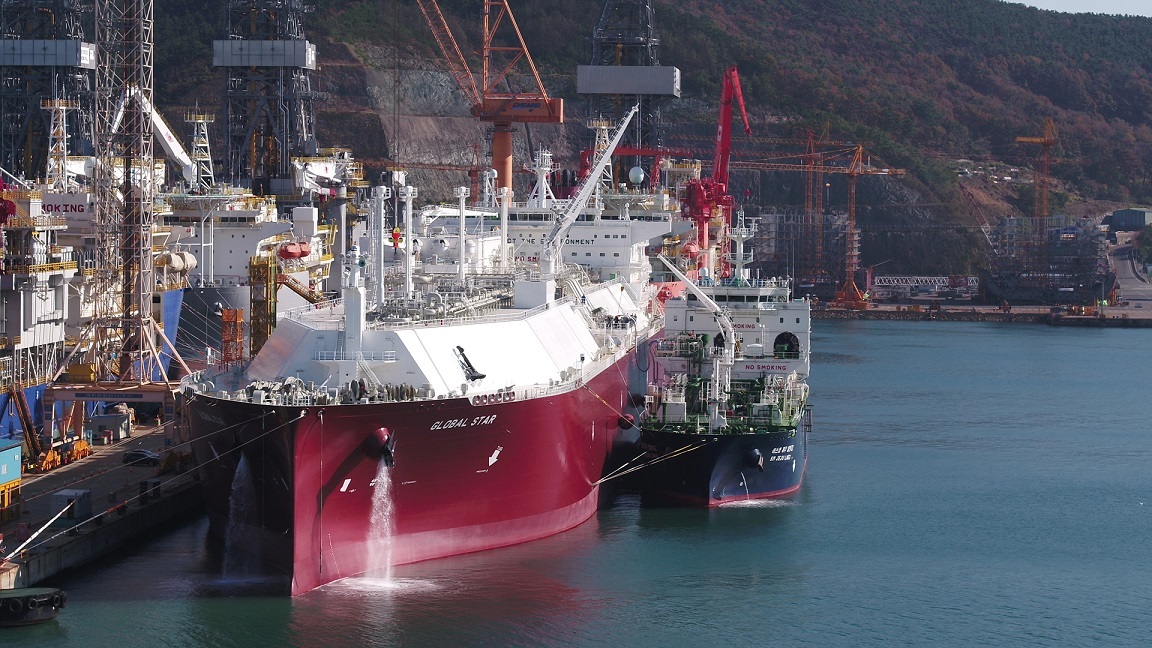Kogas completes world’s first ship-to-ship LNG bunkering test
By Kim Byung-wookPublished : Nov. 27, 2020 - 15:44

Korea Gas Corp. said Thursday it has successfully carried out the world’s first ship-to-ship liquefied natural gas bunkering test, which examines whether an LNG carrier works properly before it begins commercial operation.
LNG bunkering is the process of transferring gas to a ship.
On Tuesday, after loading 2,000 metric tons of LNG at Tongyeong in South Gyeongsang Province, Kogas’ LNG carrier SM Jeju LNG2 entered the Okpo Shipyard of Daewoo Shipbuilding & Marine Engineering on the island of Geojedo off the southern coast. There, DSME’s newly built LNG carrier with capacity of 174,000 cubic meters was connected by hose to SM Jeju LNG2 to conduct a LNG bunkering test, which was completed successfully.
Typically, when a new LNG carrier is built in Korea, it has to travel six to 24 hours from a shipyard to onshore LNG terminals in Pyeongtaek Gyeonggi Province, Samcheock, Gangwon Province , and Tongyeong to conduct LNG bunkering tests to verify whether the gas is cooled to a liquid state and loaded on the vessel properly.
In the winter season, LNG imports increase as demand goes up for heating, and those LNG terminals are packed with LNG carriers offloading the gas, making LNG bunkering tests for new vessels difficult. The recent increase in the number of LNG vessels has burdened those terminals. Kogas expects the success of the ship-to-ship bunkering test will alleviate the stress of those LNG terminals and save the cost and time spent on conventional shore-to-ship bunkering tests.
By Kim Byung-wook (kbw@heraldcorp.com)








![[Graphic News] More Koreans say they plan long-distance trips this year](http://res.heraldm.com/phpwas/restmb_idxmake.php?idx=644&simg=/content/image/2024/04/17/20240417050828_0.gif&u=)
![[KH Explains] Hyundai's full hybrid edge to pay off amid slow transition to pure EVs](http://res.heraldm.com/phpwas/restmb_idxmake.php?idx=644&simg=/content/image/2024/04/18/20240418050645_0.jpg&u=20240419100350)





![[From the Scene] Monks, Buddhists hail return of remains of Buddhas](http://res.heraldm.com/phpwas/restmb_idxmake.php?idx=652&simg=/content/image/2024/04/19/20240419050617_0.jpg&u=20240419175937)

![[KH Explains] Hyundai's full hybrid edge to pay off amid slow transition to pure EVs](http://res.heraldm.com/phpwas/restmb_idxmake.php?idx=652&simg=/content/image/2024/04/18/20240418050645_0.jpg&u=20240419100350)

![[Today’s K-pop] Illit drops debut single remix](http://res.heraldm.com/phpwas/restmb_idxmake.php?idx=642&simg=/content/image/2024/04/19/20240419050612_0.jpg&u=)